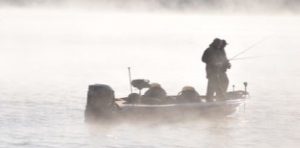2021-Oct-07
Tips for the Cold Water Boating Season
 Boating from October through June offers a very different experience steeped in solitude and excellent fishing. It is a beautiful time to be on the water. But boating during this season also requires extra attention to detail and the ability to be self-sufficient given that there are fewer boaters around should you require assistance. Here are some helpful tips from the Canadian Safe Boating Council (CSBC) and the Ontario Federation of Anglers & Hunters to make off-season boating safer for you.
Boating from October through June offers a very different experience steeped in solitude and excellent fishing. It is a beautiful time to be on the water. But boating during this season also requires extra attention to detail and the ability to be self-sufficient given that there are fewer boaters around should you require assistance. Here are some helpful tips from the Canadian Safe Boating Council (CSBC) and the Ontario Federation of Anglers & Hunters to make off-season boating safer for you.
- Check the weather forecast. The weather can change quickly and storms can be more violent. Fog is also more common.
- Ensure that your boat and engine are in good working order. Ethanol-based fuel can allow water contamination in the tank. The use of a fuel additive prevents water in the fuel line from freezing. Having a backup gas tank onboard is a good idea too.
- Leave a float plan of where you are going with a responsible person who will know what to do if you are overdue.
- Have a marine radio or cell phone.
- Have flares onboard.
- Having tools and a few spare parts can enable you to fix minor problems.
- It may seem warm outside but resist the urge to wear shorts and a T-shirt. Dress for the water temperature. This can help slow the progression of hypothermia should you find yourself in the water.
- WEAR A LIFE JACKET OR PFD. The best choices are those that offer more thermal protection such as a floater jacket and pants or a one-piece survival suit.
- Use extra vigilance for floating debris or even chucks of ice while underway.
The 1 – 10 – 1 Principle
Accidental cold water immersion can be shocking, but don’t panic. The 1-10-1 Principle is a simple way to remember the first three phases of cold water immersion.
 1 Minute – Cold Shock:
1 Minute – Cold Shock:
An initial deep and sudden gasp followed by hyperventilation that can be as much as 600-1000% greater than normal breathing. You must keep your airway clear or run the risk of drowning. Cold Shock will pass in about one minute. During that time concentrate on avoiding panic and getting control of your breathing. Wearing a lifejacket during this phase is critically important to keep you afloat and breathing.
 10 Minutes – Cold Incapacitation:
10 Minutes – Cold Incapacitation:
Over approximately the next ten minutes you will lose the effective use of your fingers, arms and legs for any meaningful movement. Concentrate on self rescue initially, and if that isn’t possible, prepare to have a way to keep your airway clear to wait for self rescue. Swim failure will occur within these critical minutes and if you are in the water without a lifejacket, drowning will likely occur.
 1 Hour – HYPOTHERMIA:
1 Hour – HYPOTHERMIA:
Even in ice water it could take approximately one hour before becoming unconscious due to Hypothermia. If you understand the aspects of hypothermia, techniques of how to delay it, self rescue and calling for help, your chances of survival and rescue will be dramatically increased.
The Canadian Safe Boating Council (CSBC) has great cold water information on and videos like the one below on their website. Check it out – it could save your life!
Additional information on cold water topics can be found here:
